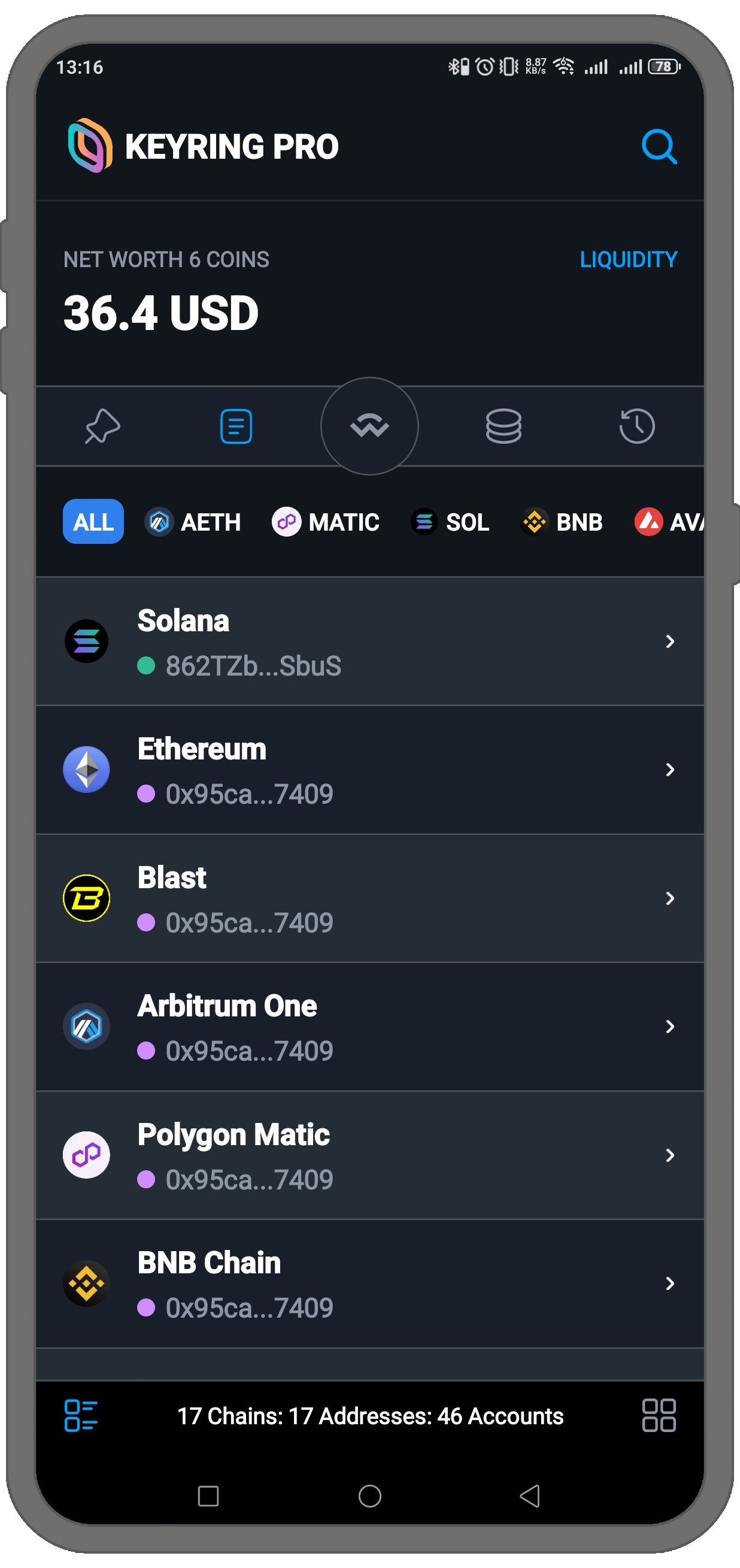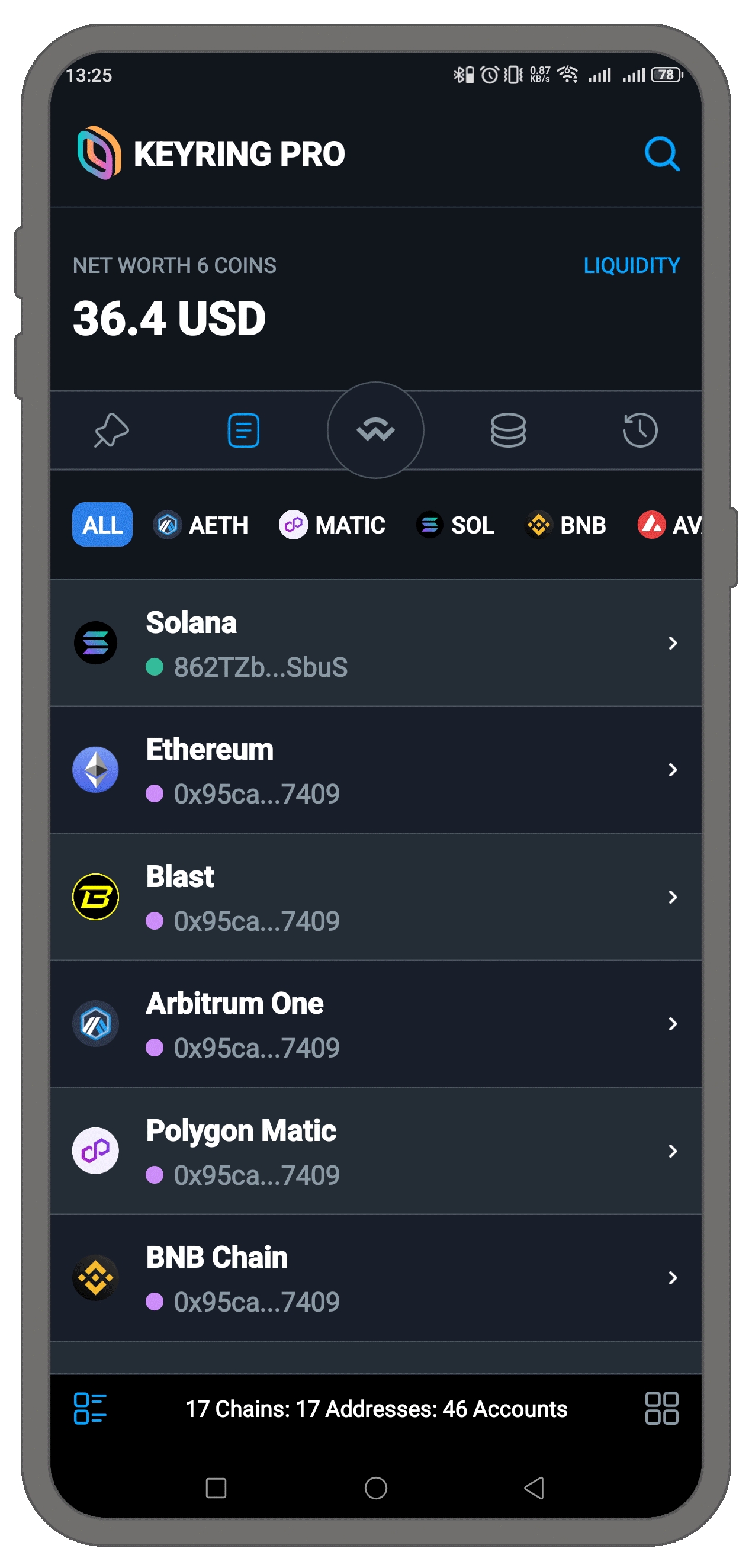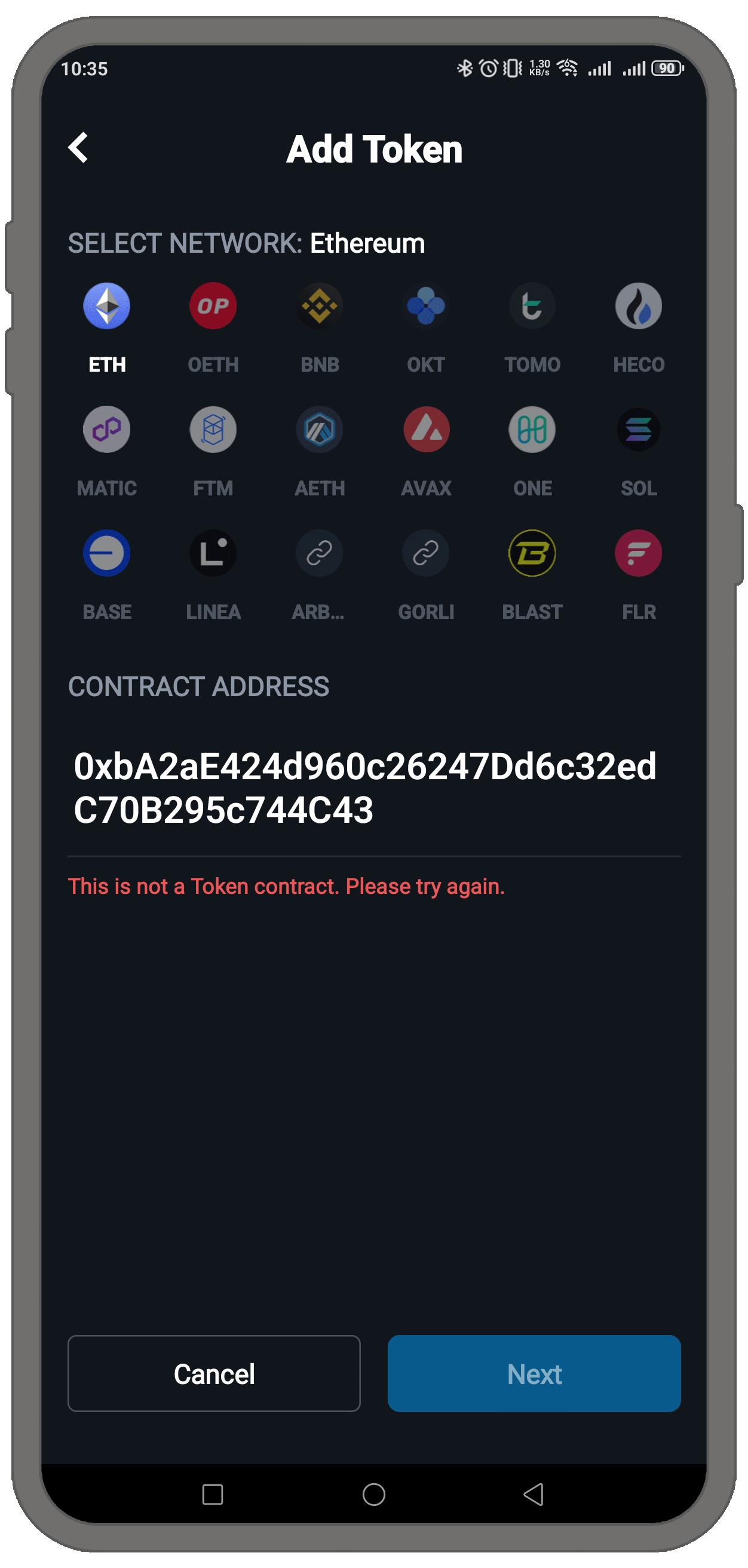FAQ
With KEYRING PRO, you can manage all of your accounts easily.
特定のチェーンだけをフィルターできますか?
はい、現在、ピン留めされた取引、アカウント、資産、履歴を含むすべての機能でチェーンをフィルターまたは並べ替えることができます。

なぜ資産価値を更新できないのですか?
KEYRING PRO Walletでは、ユーザーが資産ページを更新してトークン残高を最新の状態にすることができます。 ただし、「ALL」フィルターを選択している場合、ページの更新は10分ごとに1回のみ可能です。 特定のチェーンでフィルターをかけた場合は、いつでも更新できます。
自分が所有しているNFTを確認できますか?
はい、ただし、KEYRING PRO Walletアプリ内で直接確認することはできません。NFTを確認するには以下の手順を行ってください:
アカウントを開きます。
メニューから「NFTを見る」を選択します。
KEYRING NFT Viewerページにリダイレクトされ、そのアカウントに関連付けられたNFTを確認できます。

なぜ同じアカウントに複数の秘密鍵が表示されるのですか?
異なるチェーン、特にレイヤー1チェーンでは、秘密鍵の形式が異なるためです。具体例を挙げると:
レイヤー1チェーン: 各レイヤー1ブロックチェーン(例:Ethereum、Bitcoin、Solana)は、それぞれ独自の秘密鍵形式を使用します。そのため、複数のレイヤー1チェーンにアカウントを持っている場合、それぞれ異なる秘密鍵が生成されます。
レイヤー2チェーン: レイヤー2ソリューション(例:Arbitrum、Optimism)は、レイヤー1ブロックチェーン(例:Ethereum)の上に構築されています。通常、基盤となるレイヤー1チェーンと同じ秘密鍵を使用します。そのため、Ethereumの秘密鍵を持っていれば、それはArbitrumやOptimismのアカウントにも使用されます。
なぜNFCカードを使って新しいアカウントを作成できないのですか?
NFCカードを使ってアカウントを作成するには、そのカードが完全に空である必要があります。すでに他のアカウントを作成または保存するために使用されているNFCカードでは、KEYRING PRO Walletで新しいアカウントを作成することはできません。
NFCカードをリセットした後もNFCウォレットアドレスが表示されるのはなぜですか?
NFCカードで作成したアカウントはブロックチェーンに記録されているため、NFCカードをリセットしてもそのアカウントに関する情報は残ります。アカウント一覧に表示されますが、そのアカウントとやり取りすることはできません。
NFCカードをリセットした後、古いNFCウォレットアドレスを引き続き使用できますか?
いいえ。NFCカードをリセットすると、そのデジタルアイデンティティは事実上消去されます。物理的にはカードを持っていても、そのアイデンティティは変更されます。これにより、古いNFCカードで作成したアカウントはブロックチェーンに残りますが、そのカードのアイデンティティが変更されたため、やり取りすることはできません。
そのアカウントで取引を承認したりアクションを実行したりするには、元のアイデンティティを持った元のNFCカードが必要です。リセットしたカードでは、そのアカウントの取引を承認することはできません。
リセットしたNFCカードで新しいウォレットを作成できますか?
はい、リセット後、NFCカードは新しいデジタルアイデンティティを持つ新しいカードと見なされます。通常通り、新しいウォレットを作成したりインポートしたりすることができます。
ガス料金を増加させると取引が優先されるのはなぜですか?
ガス料金は、バリデーター(またはマイナー)に次のブロックに取引を含めてもらうためのインセンティブとなります。ガス料金を増加させることは、バリデーターに対してより高い報酬を提供することになり、取引がより魅力的になります。これにより、取引が優先され、迅速に処理される可能性が高くなります。
新しいブロックチェーンは、より高い取引量や速い処理時間に対応できるよう設計されていますが、BitcoinやEthereumのような古いブロックチェーンでは依然として混雑が発生することがあります。そのような場合、ガス料金を増加させることで、取引が遅れることなく早く処理されることを確実にする手助けになります。
スワップトークンとブリッジトークンとは何ですか?
スワップトークン
トークンをスワップするとは、同じブロックチェーンネットワーク内で1つのトークンを別のトークンと交換することです。
例:ArbitrumチェーンでARBをETHにスワップする。
ブリッジトークン
トークンをブリッジするとは、1つのブロックチェーンから別のブロックチェーンへトークンを移動させることです。このプロセスにより、異なるブロックチェーンネットワーク間で資産を移動することができ、同じトークンをチェーン間でスワップしたり、別のチェーンで異なるトークンに交換したりすることができます。
例:
ArbitrumチェーンのARBをEthereumチェーンのARBにスワップする。
ArbitrumのARBをEthereumのETHにスワップする。
ブリッジングは、異なるブロックチェーンエコシステム間の相互運用性に不可欠であり、ユーザーが複数のチェーンのユニークな機能や利点を活用できるようにします。
スリッページトレランスとは何ですか?
スリッページトレランスは、暗号通貨取引、特に分散型取引所(DEX)で使用される設定で、トークンの予想価格と実際に取引が実行される価格との間で許容される差異を管理します。この差異は、市場のボラティリティや取引処理にかかる時間によって発生することがあります。
新しく追加したトークンにトークンアイコンが表示されないのはなぜですか?
Coingeckoに上場されているトークンのみ、追加された際にアイコンが表示されます。
トークンコントラクトを入力したのに新しいトークンを追加できないのはなぜですか?
これにはいくつかの理由が考えられます。例えば、コントラクトを入力する際に間違いがあった場合です。 ただし、最も可能性が高いのは、誤ったチェーンが選択されたことです。正しいチェーンを選択すると、エラーは表示されなくなり、トークンの追加が続けられるようになります。

トークンを銀行口座に送るにはどうすればいいですか?
暗号資産を直接銀行口座に送ることはできません。銀行は仮想通貨ではなく、USDやEURなどの法定通貨を扱うためです。
暗号資産を銀行口座に送金する方法:
暗号資産を売却する: 信頼できる取引所で暗号資産を売却して現金化します。
現金を引き出す: 取引所に銀行口座をリンクし、現金を送金します。
なぜKEYRING PROで私のビットコインアドレスが異なるように見えるのか?
KEYRING PROを使用してビットコインアカウントを復元した際に、生成されたアドレスが異なって見える場合がありますが、心配する必要はありません。この違いは、ビットコインアドレスと秘密鍵の構造、およびKEYRING PROがサポートする高度なアドレス形式によるものです。以下で詳しく説明します。
ビットコインアドレス形式の理解
ビットコインアドレスにはいくつかの形式があり、それぞれ特定の目的を果たします:
P2PKH(Pay-to-Pubkey Hash):
元々のビットコインアドレス形式で、「レガシーアドレス」とも呼ばれます。
**「1」**で始まります(例:
1BvBMSEYstWetqTFn5Au4m4GFg7xJaNVN2)。
P2SH(Pay-to-Script Hash):
マルチシグネチャトランザクションなどの高度な機能を可能にする形式です。
**「3」**で始まります(例:
3J98t1WpEZ73CMmDvie4ryniWrnqRhWNLy)。
Bech32(ネイティブSegWit):
「bc1アドレス」とも呼ばれ、最も新しく効率的なビットコインアドレス形式です。
**「bc1」**で始まります(例:
bc1qar0srrr7xf4vy5k643lydnw9re59gtzzwf5mdq)。トランザクション手数料を削減し、ブロックスペース効率を向上させるよう設計されています。
ビットコイン秘密鍵の理解
秘密鍵の形式は、それに対応するアドレスの種類に依存します:
レガシー(P2PKH)アドレス: 秘密鍵は通常、**「5」**で始まります。
SegWitアドレス(P2SHおよびBech32): 秘密鍵は通常、**「K」または「L」**で始まります。
KEYRING PROと最新のビットコインアドレス形式
KEYRING PROは、最も高度で効率的なアドレス形式である**Bech32(ネイティブSegWit)**をデフォルトで採用し、ユーザーに最高のビットコイン体験を提供します。
新しいビットコインアドレスの作成:
KEYRING PROで新しいビットコインアドレスを生成する場合、常に**「bc1」**で始まるBech32アドレスになります。
これにより、トランザクション手数料が低くなり、ブロックスペースの利用効率が向上します。
ウォレットのバックアップ:
KEYRING PROでビットコインアドレスをバックアップすると、対応する秘密鍵は**「K」または「L」**で始まり、SegWit互換であることを示します。
アカウントの復元:
**「K」または「L」**で始まる秘密鍵をインポートすると、KEYRING PROは元のアドレスがP2SH形式であったとしてもBech32アドレスを生成します。 例:
3J98t1WpEZ73CMmDvie4ryniWrnqRhWNLyというP2SHアドレスをバックアップした場合、アプリはそれをbc1hbr0srrr4xfxva4l653lydnw9re59gtzzwf5octのようなBech32アドレスで復元します。
2つのアドレスは見た目が異なりますが、同じビットコインウォレットを表しています。これは、秘密鍵が両方のアドレス形式に互換性があるためであり、KEYRING PROはより効率的なBech32形式を優先します。
なぜBech32アドレスを使用するのか?
Bech32アドレスには以下のような利点があります:
低コスト: ブロックスペースを効率的に使用するため、トランザクション手数料が低くなります。
エラーチェックの向上: Bech32アドレスには、タイプミスを防ぐためのチェック機能が組み込まれています。
将来性: ビットコインネットワークの進化に伴い、Bech32アドレスは新機能をよりサポートするよう設計されています。
KEYRING PROは、最新技術を採用することで、最高のビットコイン体験を提供します。ご質問がある場合は、サポートチームまでお気軽にお問い合わせください!
Last updated